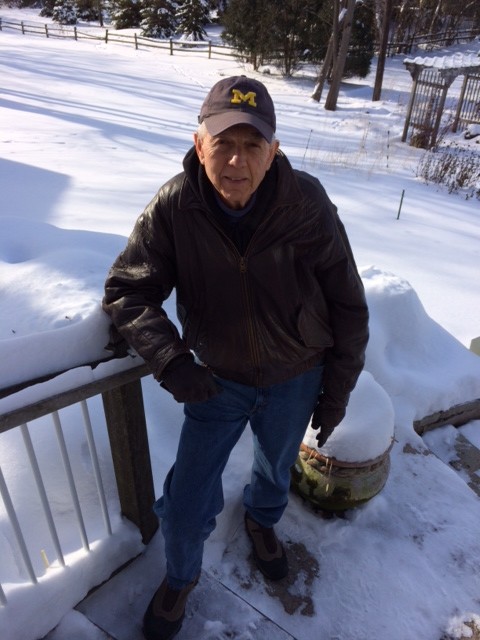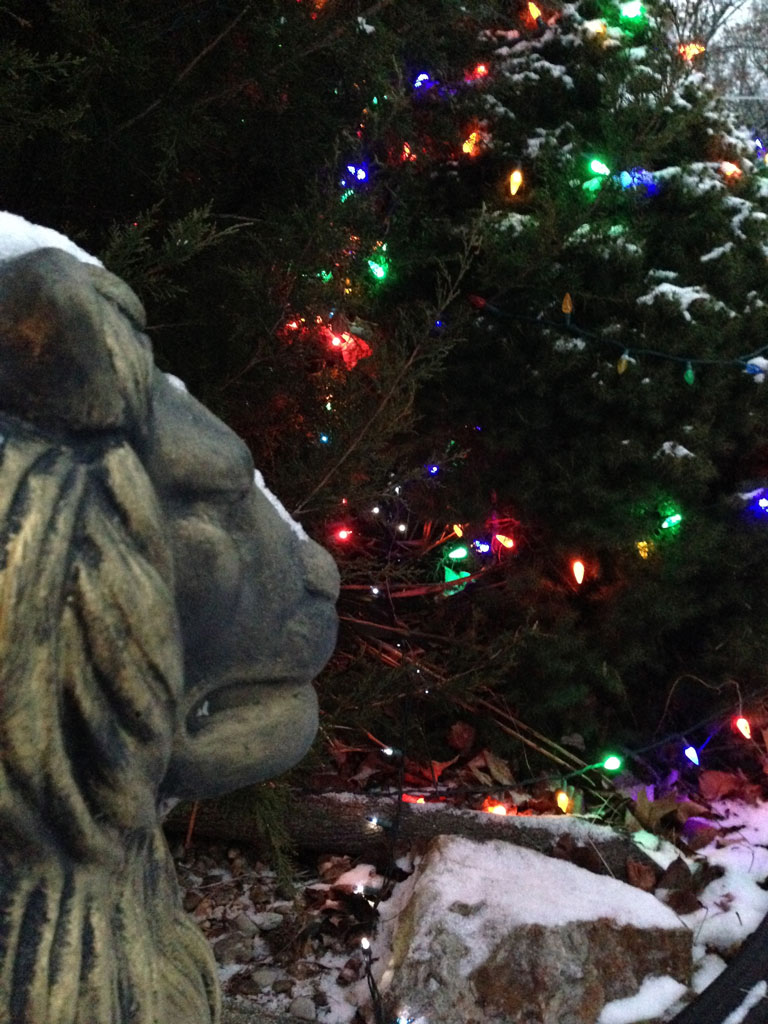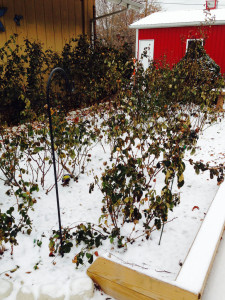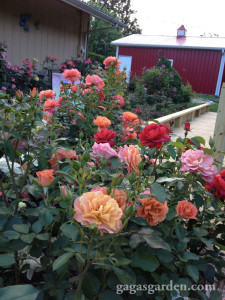

December is an exciting month. Have you ever noticed one minute it’s August and the next its Halloween, then Thanksgiving, and like a speeding train the holidays are upon us. The holidays offer so much to do you probably haven’t given much thought to extra winter protection for your roses. Tonight I did slip on my leopard rubber boots, no jacket and planned on taking the coffee grounds all the way out to the vegetable garden by the red barn. Remember the vegetable garden? It was meant to be the 3rd stage rose garden. Then I watched Doomsday Preppers and thought to myself “I’m the only one in this entire village of 1100 with a rose garden! You can’t really fill up on roses, even rose jam and toast isn’t that filling!†So “Oui†planted a veggie garden and plowed up some more yard for the next rose garden.
Â

My husband was so pleased as you can imagine. Back to the coffee grounds, I opened the garage door and saw Gene Boerner, F and thought, “this rose bush is right here, why not pour the coffee grounds on top of the leaves and mulch, and I really love Gene Boerner.â€Â By the way, roses I love often times get extra doses of fertilizer, and if you ask any gardener that is honest they’ll confess of doing that very same thing.

If you have ever heard of killin’ ‘em with kindness, it could happen. With all this said my point is it’s not too late before the winter doldrums set-in and the really hard freezing weather of the long hard cold winter to consider if you have enough winter protection on your roses.
Â
The following is a guest post that is by Jack Falker of Minnesota of the Twin Cities Rose Club. I accidentally said he was from the hinterlands and he corrected me. All right Minneapolis is a very sophisticated city and not the hinterlands; he’s from the frozen tundra of Minnesota. He has some wonderful tips on winter protection and he sent the following article specifically for me to reprint in the American Rose Society Illinois Indiana Newsletter the IlliAna Newsletter of which I am the editor.
Â
Jack Falker, the Minnesota Rose Gardener, says:
Â
“Unlike those of us who live in USDA zones 4 and 5, where the ground freezes solid in the winter, most of the folks in Illiana, who are in either zones 6 or 7 these days, can probably just rely on the mounding process for your roses and wait to see if you get snow cover to insulate your beds.  However, I would put some added insulation on the plants not later than the latter part of December, as a precaution against repeated freezing and thawing. There really is no downside to putting on your insulation earlier, just as long as you put something around your plants to deter the inevitable onslaught of voles.â€

Winter in Illiana
By Jack Falker
 (The Minnesota Rose Gardener)
Minneapolis
What you do for winter in your rose garden depends a lot on where you live, of course, but one basic principle applies if you live in a cold zone, i.e. USDA Zones 3, 4, 5 and most of 6. Â Your objective is to keep your roses frozen; not to keep them from freezing! Â There seems to be a lot of confusion about that and thus we have nurseries selling styrofoam rose cones, which serve as little ovens in the winter when the sun shines on them, causing plants to freeze and thaw repeatedly, thereby killing them.
But first, do you think you really know your coldness zone? Of course, you can check out the latest USDA Plant Hardiness Zone Map (published in January 2012) and it’ll show you that you live in either zone 5 or zone 6, unless you are in the most southern tip of Illinois, which is in zone 7. Most people take that as gospel, but did you know that this is the first time in 20 years that the USDA has updated this information? It covers the 30 year period from 1976 to 2005, so it’s already eight years out of date and, importantly, those eight winters were among the warmest in the last 50 years. That, in my mind, makes this information pretty unreliable. The National Arbor Day Foundation published their own zone map back in 2006, which shows virtually all of Illinois, Indiana, the lower peninsula of Michigan and Ohio in zone 6. It also shows most of southern Minnesota and almost all of Iowa in zone 5, which is a big change, even without taking into account the much warmer winters since it was published. Here’s that map compared with the latest USDA map, which seems pretty inaccurate based on actual experience.
Â
Â
So, given that winters have changed in recent years, ask yourself what winter is really like now where you live. Before you confidently recite that you are in zone 6, ask yourself when was the last time you remember a winter that was between zero and minus 10?  Or if you think you are still in zone 5 (where the USDA Map above shows most of northern Illinois) ask yourself when was the last time you remember winter temperatures being -10 to -20? I believe that if you give this some serious consideration and discuss it at your various club meetings, my guess is you will find that virtually all of northern Illinois and Indiana are in zone 6 and substantial portions of southern Illinois and Indiana are experiencing consecutive winters that do not go below zero, firmly placing them in zone 7.
Â
My conjecture is based on 51 years of data that I have compiled for the Twin Cities of Minneapolis and St.Paul. While the USDA continues to place us in zone 4, the National Arbor Day map shows us in zone 5, and my temperature chart below confirms that not only are we in zone 5, but are on a statistically valid trend line path that is moving us quickly toward zone 6. So, if we interpolate this data further south to Illiana, we should be seeing similar changes.Â
Â
So what does all of this portend for winter protecting your roses in Illiana? I began by saying that the objective of winter protection in zones 3, 4, 5 and 6 is to keep your roses frozen so they don’t repeatedly thaw and freeze again, thereby killing them. Well, if Illiana is virtually all zone 6 and 7, it stands to reason that you all might have a different, but perhaps equally difficult problem; that is, keeping them from freezing in the first place. Fortunately, I believe the solution is virtually identical, i.e., some acceptable method of insulating each rose, either before it freezes or afterward to keep it frozen.
Â
First, it is important if you are growing grafted roses, that your bud unions should be several inches below the surface of the ground to insulate them. I recommend planting the bud unions five or six inches down so the roses can develop their own feeder roots above the bud union as an added bonus. I also recommend growing as many roses as possible on their own roots. I plant all my own-root roses with the crown several inches below ground for good insulation and root development.
Â
Once your bud unions are at least somewhat below grade or, even better, if your roses are growing on their own roots, here is what I recommend for winter protection. Â Year-round, mulch your beds with at least three inches of wood chips overall, and in the late fall pull more of those chips up around your plants from the area surrounding them, so you have five or six inches of chips around every plant (in the summer fewer chips are desirable around the plants, to work in fertilizer, coffee grounds etc.). Next, mound a couple of shovels full of compost from your mulch pile around every plant. Â My mulch pile is primarily shredded oak leaves from last fall and hundreds of pounds of composted Starbucks coffee grounds that I collect regularly.
Â
Next, when it starts getting cold and your roses have stopped blooming, bind them into bundles and cut them down to about 12 inches. (Don’t worry, you’re not losing anything here; what you want is the strong new growth you will get in the spring.)  Here’s what this looked like when I was cutting back my mounded Buck Earth Song bed with my hedge trimmer, in preparation for putting on leaf bag insulation.
Â
Â
Â
Â
The next step is to prepare a bunch of half-full, regular plastic leaf bags. Â For heaven’s sake, don’t use the compostable leaf bags (as I did one winter, picking them up from neighbors’ leaf bag piles). Â They break down over the winter and leave you with piles of leaves to clean up!
Â
When you put these bags on your roses will differ, depending on where you live in Illiana.  In zone 5 and the colder parts of zone 6 (like Chicagoland), wait until the ground freezes lightly, before putting them on.  A good signal around here is when our local ponds get a skin of ice on them for the first time. Now, with the objective of keeping your roses frozen, one-by-one slit open the bottoms of your leaf bags and shove them down on each of your plants, flush with the mounds. In the warmer parts of zone 6 (or colder parts of zone 7), you can probably just rely on the mounding process and wait to see if you get snow cover to insulate your beds.  However, I would put the leaf bags on the plants not later than the latter part of December, as a precaution against repeated freezing and thawing. There really is no downside to putting on your insulation earlier, just as long as you put something around your plants to protect them from the inevitable onslaught of voles. In that regard, please see my Minnesota Rose Gardener blog articles on vole protection:
http://jack-rosarian.blogspot.com/2013/09/voles-and-castor-oil.html .
The use of construction blankets for winter protection has also become quite popular up here in Lake Wobegon and I believe it could be very useful in Illiana, with your freeze/thaw issues. I will be writing a blog on this method, which can be incorported as another article for Illiana in the near future. In the meantime, here is a picture, taken by my friend Deb Keiser, rose specialist at the Virginia Clemens Rose Garden in St. Cloud, Minnesota, of her garden all covered up for winter in mid-November. Just imagine!
Â
Â
Â
Please feel free to address any questions to jack@falkerinvestments.com. Have a nice warm winter!




